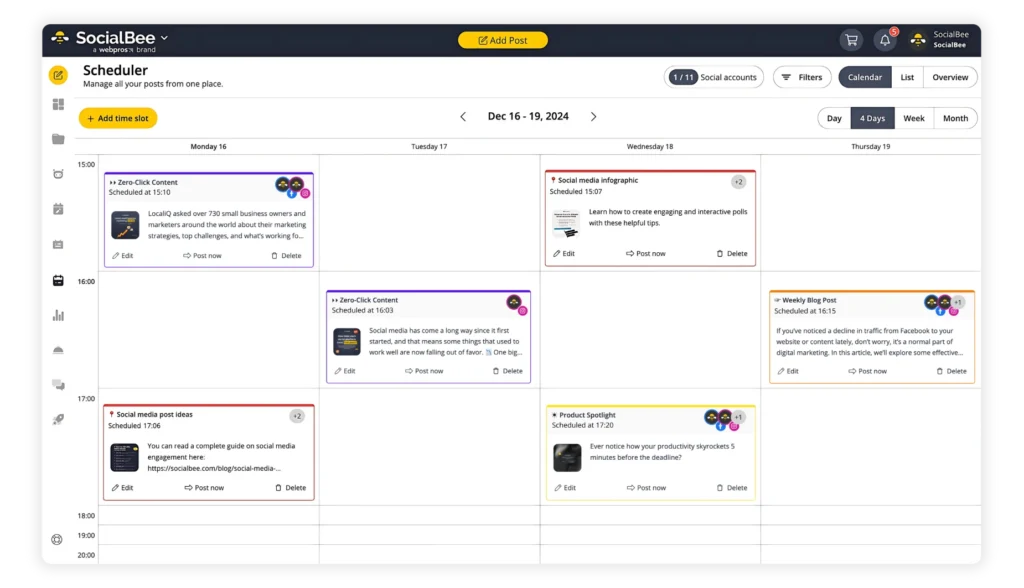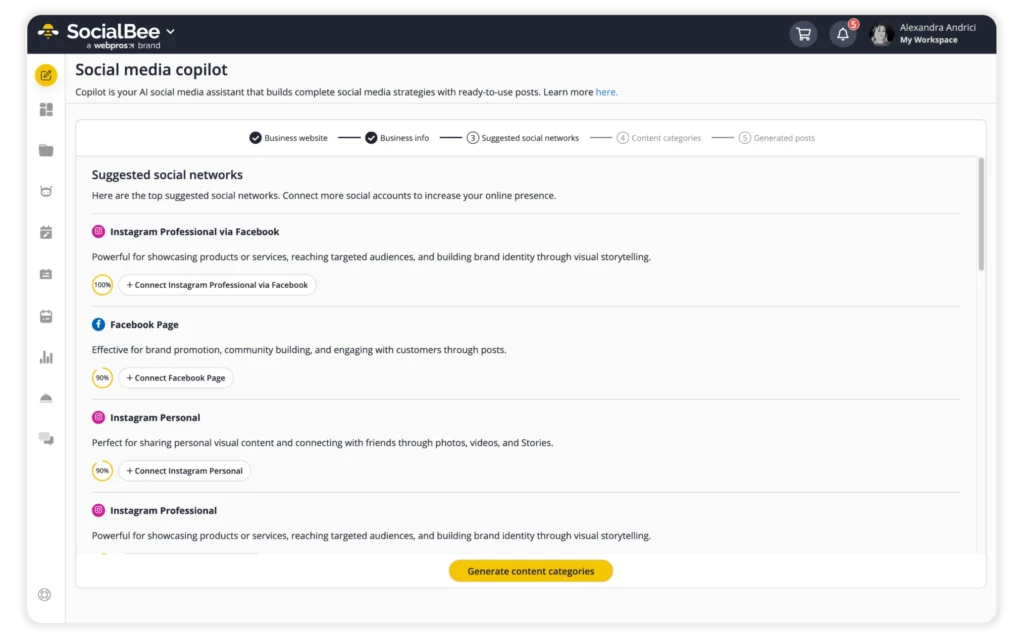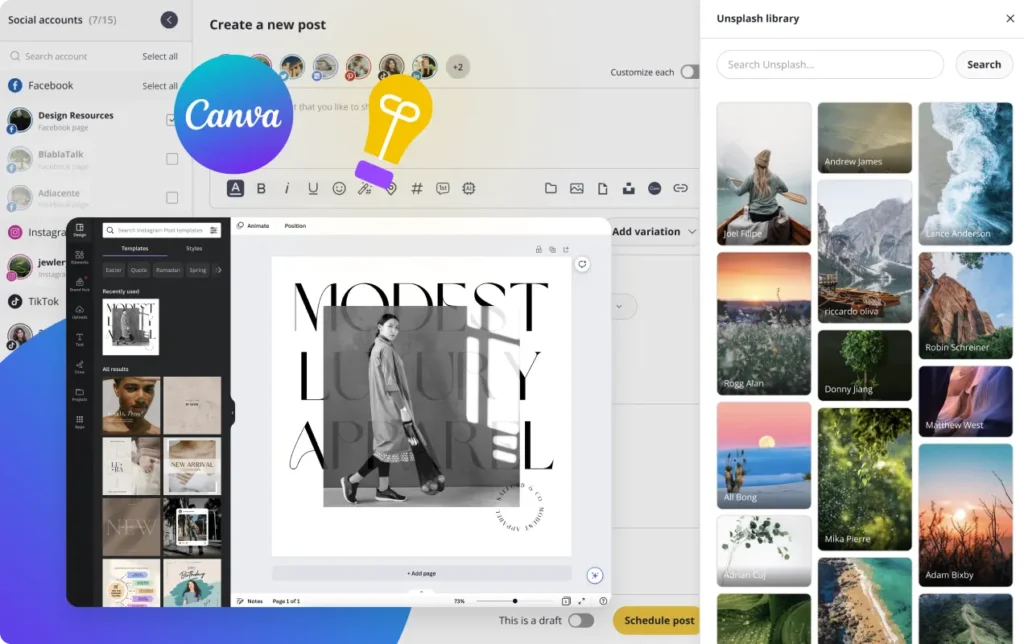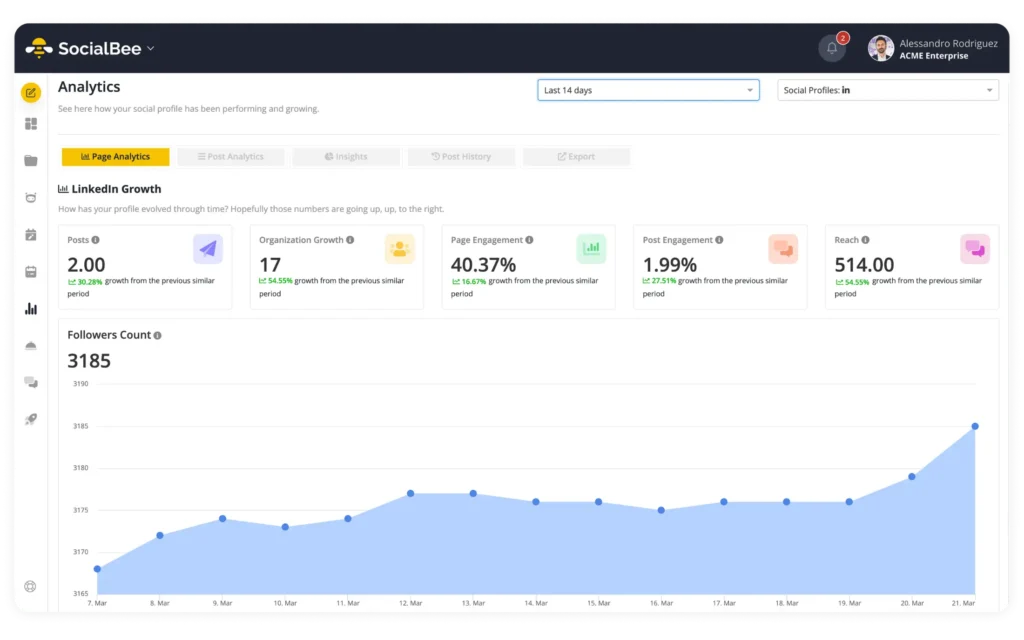
Guest Author
Cross-posting on social media, whether loved or loathed, is undeniably central to the thriving digital universe—an excellent marketing tool in its own right.
This digital landscape is constantly evolving, with multiple social media platforms popping up annually and existing ones undergoing frequent changes. This dynamic environment forces marketers to continuously adapt their strategies to leverage new opportunities.
Cross-posting is one such evolving tactic, gaining traction among both novice and seasoned marketers. In this article, we will explore the numerous benefits of cross-posting content and how to effectively implement a cross-posting social media strategy in your marketing efforts.
We’re SocialBee LABS SRL, part of WebPros. We use the information you provide to share relevant content and product updates, as outlined in our Privacy Policy. You can opt out anytime.
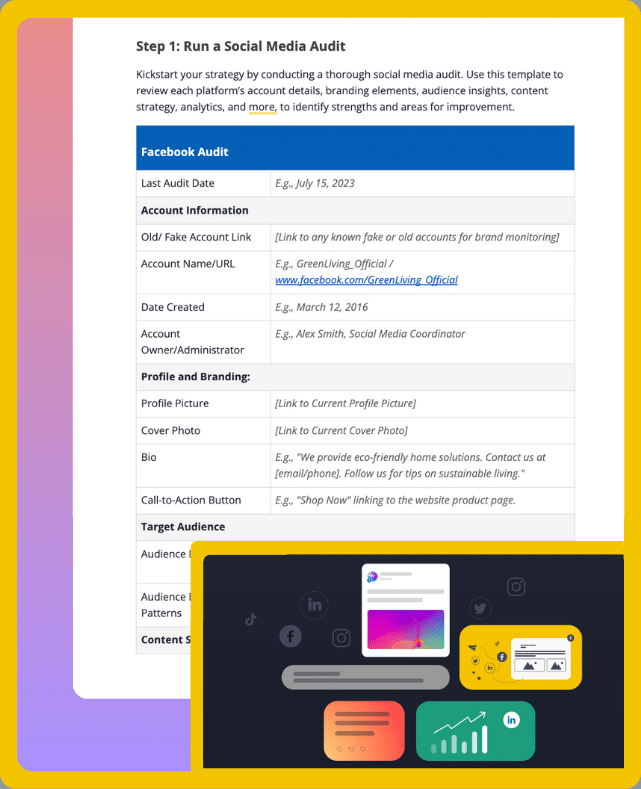
Short Summary
- Cross-posting on multiple social media platforms involves sharing the same content across these channels but tailored to fit each platform’s unique audience and format.
- It’s crucial to adapt your content to the specificities of each social media platform. For example, LinkedIn suits professional and thought-leadership content, while Instagram is ideal for visually engaging posts.
- Tools like SocialBee enhance the cross-posting process by allowing scheduling, message tailoring for each platform, and tracking engagement from a single dashboard.
- Cross-posting helps in reaching a broader audience, saving time in content creation, and reinforcing brand messaging across various platforms.
- Effective cross-posting involves choosing the right type of content for each platform, optimizing images, using platform-specific captions, avoiding excessive cross-posting, and using analytics to refine the strategy.
What Is Cross-Posting on Multiple Social Media Platforms?
Social media cross-posting involves sharing the same content across different platforms with slight adjustments to fit each one.
For example, you might post a photo on Instagram with a lengthy caption and hashtags. Then, you use the same photo on Twitter but shorten the caption due to character limits and tweak the hashtags. On LinkedIn, the caption might be more formal and professional.
This way, you efficiently maintain an active presence on multiple platforms, ensuring your message reaches a wider audience while being tailored to each platform’s unique style and audience.
SocialBee, Your Social Media Cross-Posting Tool
Tools like SocialBee take cross-posting to the next level by allowing you to manage and post content on multiple platforms simultaneously. With SocialBee, you can schedule posts, tailor messages for each platform, and even track engagement, all from one dashboard.
This not only streamlines the content distribution process but also ensures that your message is consistently delivered across all channels, saving you time and amplifying your online presence.
Manage your cross-posting game more productively with SocialBee – an all-in-one social media management solution.
Start your 14-day free trial now!
Here’s a summary of SocialBee’s key characteristics:
- Support for multiple platforms: SocialBee, a versatile cross-posting software, enables you to create content for a broad range of platforms, enhancing your social media presence on Facebook, Instagram, Threads, X (Twitter), LinkedIn, Pinterest, Bluesky, Google Business Profile, TikTok, and YouTube.
- Visual tool integrations: Import and curate visuals from Canva, Unsplash, and GIPHY, directly from SocialBee.
- AI-driven content creation: Utilize the AI Post Generator for crafting captivating captions and images, key to growing new followers on multiple social media accounts. You can also craft your entire cross-posting strategy with the help of our Copilot.
- Content categories: Efficiently categorize your content with SocialBee to maintain a diverse and dynamic presence across various platforms.
- Automated blog content import: Streamline your content strategy by automatically integrating blog content via RSS Feeds, keeping your social media feeds fresh and relevant. You can also choose to cross-post your blog content across various platforms in order to have an active posting schedule.
- Platform-specific customization: Tailor your posts for the unique format and audience of each social platform, ensuring your message resonates with different groups.
- Evergreen content scheduling: SocialBee’s evergreen posting feature streamlines cross-posting by allowing the automatic reuse of content across multiple social media platforms, ensuring consistent and efficient distribution.
- Structured posting schedule: Establish a structured posting schedule across all your social media accounts, making sure you post at peak engagement time on every social media platform.
- Performance insights: Gain in-depth insights into the growth of your accounts and the impact of individual posts, helping to find out your best-performing social media media platform and refine your strategies for reaching a larger audience.

What Are the Benefits of Cross-Posting on Multiple Platforms?
Like many tried-and-tested tactics on social platforms—influencer marketing, user-generated content, and so on—cross-posting has several advantages.
For instance, a small brand with a limited marketing budget may use a cross-posting strategy to multiply the value of a piece of content. A new and emerging business may spread its content across multiple channels to boost reach.
Let’s take a look at the top three benefits of cross-posting social media content:
- Reach more of your audience
- Save time on content creation
- Reinforce your messaging
1. Reach More of Your Audience
As mentioned, cross-posting on various social platforms is a great way of boosting your content’s reach and connecting with broader audiences.
Remember, each individual platform—whether it’s Facebook, LinkedIn, TikTok, or Instagram—attracts different users with different preferences. If you’re only posting to LinkedIn, the portion of your target audience that uses Facebook will miss out.
So, by sharing the same content on each platform, you increase the chances of your brand messaging reaching people who you truly want to engage with.
2. Save Time on Content Creation
As a marketer, you don’t need us to tell you how laborious the content creation process can be. Crafting original and optimized content for every single social media platform takes considerable time and resources.
Cross-posting content tailored for each platform saves you valuable time— time that’s better spent working on other essential tasks, like responding to comments from your target audience, creating KPI reports, and developing new marketing ideas.
3. Reinforce Your Messaging
Consistency is key when it comes to marketing strategies—and cross-posting is all about consistency. By reinforcing your messaging in individual platforms, you ensure your core content and promotions are shown to more followers.
Repeating these core marketing messages increases the chance that your target audience will absorb and remember your message. But it also helps to cement a clear voice and tone as part of your brand identity, which is crucial for managing your online presence in today’s digital world.
On top of this, it’s essential to use recognizable website formatting and consider a few different domain hacks and tips to help you standout. For your website, use a content funnel to direct viewers through the customer journey and lead them to your product or service.
Keep in mind that as part of your strategy, you must keep a consistent branding across your website and social media networks. You want your brand image to be cohesive so it becomes instantly recognizable for your audience no matter which platform they’re engaging with you on.
Chances are a lot of your cross-promotional content will direct followers to your website, so you want to guarantee a seamless experience across both.
Here are some things to consider for a great website presence:
- A recognizable domain: Would local audiences recognize your website domain? For instance, is your UK domain “.co.uk” or US domain “.com”? If not, it might be time to invest in a new website URL or consider using more than one domain, to appeal to different audiences.
- Consistent visuals: Do your visuals match across all channels? A brand style guide can go a long way in ensuring consistency. Make sure yours outlines brand colors, fonts, and logo formats that should be used in different instances.
- Compelling messaging: Is your tone of voice the same on your website and social media channels? If not, create a content style guide that reflects your voice, values, and personality.
How to Cross-Post The Right Way on Social Media
Despite the numerous benefits, cross-posting doesn’t have a 100% success rate (much like many other social tactics). To be successful, you need to post quality content that’s adapted to each social media channel and meets a specific purpose—whether that’s to inform, entertain, or persuade.
You should also always point the audience to a unique link to your product page or business website to boost your sales and conversions.
Here’s how to cross-post social media content the right way:
- Adapt your content to each social media platform
- Choose the right content type
- Optimize your images for different platforms
- Avoid excessive cross-posting
- Use analytics to improve your strategy
1. Adapt Your Content to Each Social Media Platform
In the world of social media cross-posting, recognizing the uniqueness of each platform is essential. Think of it like tailoring a suit—it should fit flawlessly. By their very nature, each social network is home to a niche audience in terms of age, culture, behavior, and expectations.
Here are some actionable tips to effectively tailor your captions:
- Engage with questions and calls to action: Increase interaction by asking questions or inviting actions, particularly on platforms like Instagram or Facebook.
- Use hashtags wisely: Hashtags can significantly extend your reach. Use them strategically on Twitter and Instagram, and more sparingly on LinkedIn.
- Balance witty remarks with professional tone: Twitter is great for humor, but align it with your brand voice. On LinkedIn, keep a formal tone while adding personality.
- Keep it concise when necessary: On platforms like Twitter and TikTok, with a character limit, make your message impactful yet brief.
So adapting your content to resonate with the characteristics of each platform ensures your messaging is harmonious.
With SocialBee, you can customize your social media content based on the platform you’ll share it on.
Create different versions of your post for each social media platform.
2. Choose the Right Content Type
It goes without saying that choosing the right content is essential. After all, it could be the difference between your message resonating with your audience or posts falling flat.
As we’ve mentioned, different social media platforms attract different audiences. So taking time to choose the best content to share on each platform ensures your message aligns with the audience’s expectations.
Let’s take a look at each popular social media channel and the content it best suits:
- Facebook: With roughly three billion users in 2023, Facebook is by far the biggest social media platform. You can post various types of content, from long-form posts, articles, images, and videos, or join forums relevant to your industry, the products and services you offer, or your customers’ interests.
- Instagram: Thriving on visual storytelling, Instagram best suits high-quality images, Reels, Stories and captivating visuals.
- Twitter: Designed for short yet impactful communication, Twitter (or X, as it’s now called) is perfect for quick company updates and engaging in real-time conversations.
- Threads: Still relatively new, Threads was created to rival Twitter. The short and sweet nature makes it ideal for sharing company updates, quick thoughts, and connecting with customers more closely.
- TikTok: This platform thrives on short, engaging videos that capture viewers’ attention within seconds. Some of the platform’s most popular videos are funny and involve popular trends.
- LinkedIn: Known as the professional network, LinkedIn is the perfect place to promote your blog with short-form articles and some long-form content such as thought-leadership pieces.
SocialBee’s Copilot simplifies the process of strategically planning your social media posting, helping you choose the right content type for all social channels.
Let Copilot build your social media strategy from scratch.
3. Optimize Your Images for Different Platforms
Even on the more text-heavy platforms, images are the visual language of social media, grabbing people’s attention as they scroll through post after post after post.
Just as a skilled translator adapts a message to suit a different audience, optimizing images for various platforms is essential. Resize and format your images to align seamlessly with the unique specifications of each platform.
Here’s a quick guide for aspect ratio for some of the major platforms:
Instagram:
- Square images: 1080 x 1080 pixels
- Portrait images: 1080 x 1350 pixels
- Landscape images: 1080 x 566 pixels
- Stories: 1080 x 1920 pixels
Facebook:
- Profile picture: 170 x 170 pixels on desktop, 128 x 128 on smartphones
- Cover photo: 820 x 312 pixels
- Shared images: 1200 x 630 pixels
- Shared link preview image: 1200 x 628 pixels
Twitter:
- Profile photo: 400 x 400 pixels
- Header photo: 1500 x 500 pixels
- In-stream photo: 1600 x 900 pixels (minimum 600 x 335)
LinkedIn:
- Profile picture: 400 x 400 pixels (minimum 200 x 200)
- Cover photo: 1584 x 396 pixels
- Shared image or link: 1104 x 736 pixels
- Company logo: 300 x 300 pixels
Pinterest:
- Pins on main page appear as 236 pixels wide (height is scaled)
- Expanded pins have a minimum width of 600 pixels
- Board cover image: 222 x 150 pixels
TikTok:
- Profile photo: 200 x 200 pixels
- Video resolution: 1080 x 1920 pixels
YouTube:
- Channel profile image: 800 x 800 pixels
- Channel cover photo: 2560 x 1440 pixels (with safe area of 1546 x 423 pixels)
- Video thumbnails: 1280 x 720 pixels
Remember, these sizes can change as platforms update their layout and design, so it’s a good idea to occasionally check for the latest specifications.
Design visuals directly from SocialBee and obtain a consistent and instantly recognizable look and feel for your brand on all of your social media accounts, while matching the platform requirements.
Create high-quality visuals in Canva directly from the SocialBee app.
4. Avoid Excessive Cross-Posting
Cross-posting is a double-edged sword; when wielded wisely, it can amplify your message, but excessive use may dull its impact. Select your cross-posted content thoughtfully, reserving it for significant announcements or universally appealing content.
Try to find a balance between being consistent with cross-platform posting and knowing when to leverage platform-specific engagement.
5. Use Analytics to Improve Your Strategy
Data is your compass. Like any marketing campaign, it’s useful to use analytics to gauge how effective your cross-posting strategy is. Some of the best metrics to monitor include engagement rate, click-through rate, and conversion rates—you can use social media monitoring tools to help you do this.
With these valuable insights, you can determine whether your efforts are paying off and refine your approach accordingly.
SocialBee provides comprehensive social media analytics in an aesthetically appealing layout, simplifying the process of understanding your performance metrics while eliminating the need for you to manually create graphs and charts.
Monitor all your social media channels from SocialBee and learn how to improve your performance in real-time.
Frequently Asked Questions
Yes, it’s okay to post the same content on different social media platforms, but it’s important to tailor it to suit each platform’s unique audience and format. This approach allows for consistent messaging and broader audience reach while saving time and resources.
Cross-posting involves sharing the same content across various platforms with modifications to suit each platform’s specific audience and format. Multi-posting, on the other hand, means posting the exact same content, without any changes, across multiple social media channels.
Cross-posting, while efficient, can lead to several disadvantages. One primary concern is platform incompatibility. Different social media platforms cater to distinct audiences and have their own set of norms and formats.
Content that is effective on one platform might not engage users on another, leading to a mismatch in communication. Additionally, when the same content is shared across multiple platforms, it can overlook the unique features and strengths of each platform, potentially reducing the overall impact and engagement of the content.
Boost Your Engagement With Cross-Posting Strategies
In conclusion, cross-posting is a powerful strategy for expanding your digital footprint and enhancing engagement across multiple social media platforms.
Leveraging a tool like SocialBee can transform the way you manage your online presence, offering ease, efficiency, and effectiveness in your content strategy. This approach not only connects you with a wider audience but also ensures that your message resonates consistently across different channels.
As you adapt and refine your strategies with these tools, you’re poised to witness a significant uptick in follower interaction and brand visibility. Embrace the full potential of cross-posting to elevate your social media game. Ready to experience the impact for yourself? Start your 14-day free SocialBee trial!

About the author: Frances King leads customer acquisition at OnlyDomains, a domain management solution that offers global services and support that can be accessed from anywhere in the world. Francis has been a part of the team since 2009. He is our go-to guy for everything online advertising.
Originally from Melbourne, Francis cannot go a day without lifting weights; he is considering taking on Jiu-Jitsu next. Francis has written for other domains such as VMblog and WebSitePulse.

